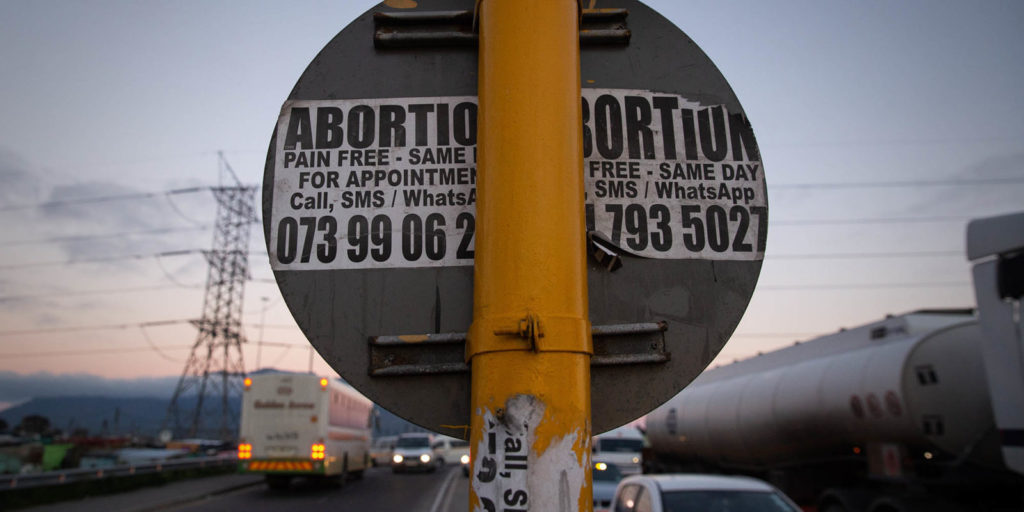It’s time to make good on the promise of the Termination of Pregnancy Act
[image]Abortion advertising on a road sign in Bonteheuwel, Cape Town. (Photo: Ashraf Hendricks/GroundUp)
Access to safe abortion services in South Africa is riddled with barriers that leave women to resort to seeking unsafe services with dire health consequences and even death. We are looking forward to the passing of the national abortion guidelines, as there is a need to urgently address the barriers women face.
However, access to safe abortion services in South Africa is riddled with numerous barriers that leave women with no choice but to resort to seeking unsafe services with dire health consequences and even death. Now that the elections have come and gone, we are looking forward to the passing of the national abortion guidelines, as there is a need to urgently address the barriers women face.
In 1996 South Africa passed the Choice on Termination of Pregnancy Act, progressive legislation that is undoubtedly amongst the best abortion laws in the world. More than 20 years later, the implementation of the Act remains a challenge. Access to safe abortion services is riddled by gross health system deficiencies.
A 2017 Amnesty International report titled Barriers to Safe and Legal Abortion Services in South Africa, paints a dire picture, revealing that in a country with more than 3,000 public health facilities, only 505 are designated for abortion services, and only 264 out of these provide the service.
What makes things worse is that there is no way to tell where to find the 264 facilities, making getting an abortion, from a public health facility, extremely difficult for women and worse for those with limited resources and those living in rural settings. The limited number of such facilities is an indication of a health system that is failing to fulfil women’s rights to sexual and reproductive health care, rights that are documented in the South African Constitution.
For a health system to be fully functional, the World Health Organisation recommends the following building blocks: service delivery, health workforce, health information systems, access to essential medicines, financing, and clear leadership and governance.
The South African health system has been declared, by the president of the country, to be in a crisis. The building blocks are not only frail but are continuously deteriorating and require urgent rehabilitation.
While all healthcare services suffer under such conditions, services like abortion care deteriorate even more. Evident shortage of health professionals willing to provide the service, exacerbated by unregulated conscientious objection, makes safe abortion care highly inaccessible.
On the other hand, the common and long drawn out stock-outs of sexual and reproductive health commodities such as modern contraceptives have undoubtedly impacted the demand for abortion services. And, of course, governance challenges in public health facilities manifest themselves in the derelict state of many hospitals and clinics across the country.
The limited access to abortion care calls for strategic and innovative approaches to the implementation of the Act. We therefore hope that the national abortion guidelines, developed by the Department of the Health in collaboration with key stakeholders, will address the existing implementation gap. We also know that the crisis in the health system is not a conducive environment for the implementation of any policy.
The launch and implementation of the national abortion guidelines should, therefore, be seen as an opportunity to revive the existing health system into one capable of delivering on women’s rights stipulated in our Constitution.
As a country, we can attest to having some impeccable policies and laws, but history has shown that implementation is not our greatest strength. That is why we need to think critically about how we will facilitate the implementation of these guidelines because they provide the opportunity to improve healthcare services for women and provide them with agency in making sexual and reproductive health decisions.
Currently, research shows that many women and youth across South Africa lack the knowledge and support systems around sexual and reproductive health, leaving them vulnerable to an unplanned pregnancy and unsafe abortions. That is why we need to be creative in how we provide our services, including being more responsive to women’s needs.
While the health system is notably in crisis, progress in our country and across the world is cause for hope. To seize this moment, it is time to make good on the promise of the Act. The government and its partners must ensure adequate resources for sexual and reproductive health services and information to close the current gaps in the system.
This should include comprehensive sexuality education, which will enable young people to protect their health, well-being and dignity. Partners from all sectors must also play their part in ending the stigma that prevents women from seeking services and providers from giving them that required service.
As we progress into a new administration, we should take all possible steps to ensure that women have access to all services that they need, when they need them, to help them realise a right that is theirs and theirs alone. DM
Dr Daphney Conco is a Public Health Specialist and a Senior Lecturer at the Wits School of Public Health


